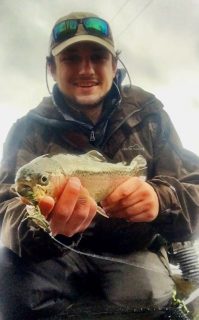Streamer fishing is a technique that every angler seems to have an opinion about. Often I find, as a guide that it is also one of the most misunderstood methods of fly-fishing I’ve ever come across. The popularity of fishing with streamers, and with the expansion of fly design over the last few years, has seen with it more and more anglers using the technique, but unfortunately not maximizing their opportunities with it. I’m not going to cover every single facet of using streamers (there’s a myriad of great information out there on tackle, flies, etc.) but I’ll try to cover some lesser-known facts to improve your streamer game this upcoming year.
A streamer can be one of the most versatile tools in your arsenal of flies. The combination of retrieves is almost endless, but more often than not, I see many anglers doing the same mundane “strip – pause – strip – pause” rhythmic presentation that sometimes might not be the most effective. You have to take into account how your streamer is acting underwater instead of just chucking it out into a run and “hopping” the fly rather than hunting the fly. I find that short, erratic strips in which the fly line is being pulled by your stripping hand less than an inch at a time in most cases can lead to more strikes. Stripping a fly too quickly/too much can often times put the fly in a position in the water column where a trout never even has a chance to see it. Visualizing what your fly is doing underwater does wonders to see how your streamer actually behaves. Try casting it out into shallow water where you can see your fly, and take note of what it does during different retrieves to help you decide the best way to cover water with it.
I try to keep my streamer colors very simple. As a general rule, I fish lighter colored and smaller streamers in clear water conditions and darker, sometimes larger patterns in stained water. Many anglers have a misconception that, when the water is muddy, they have to throw a flashy bright colored fly, and this couldn’t be further from the truth. Darker patterns with beefy profiles throw off a silhouette that stands out in colored water better to the fish. If I had to pick three colors to base a streamer off of, I would choose white, black, and olive which will cover most situations an average angler will run into.
Streamers have a well-deserved reputation for hooking into larger than average fish on any given river. Maybe the most misunderstood part of streamer fishing is that you’ll always hook into a monster brown or rainbow every time you venture out on the water. I can’t tell you how many 7-8” fish have tried to take a whack at a streamer that is almost as long as they are, and it happens more often than one would think. Streamer fishing for big fish (and in general) takes a lot of dedication and patience. I can promise that hooking into a large trout with a streamer will often require many fishless hours and some frustration on the angler’s part. However, I can also promise that watching a fish swim out of cover to chomp on your streamer will be a memory that will last a lifetime.
Ethan Hollifield is a native North Carolinian from Spruce Pine. While earning a degree in Parks and Natural Resource Management from NC State, he was a member of the three-time national championship-winning bass fishing team “BassPack”. Ethan currently guides for Stonefly Outfitters in Burnsville, North Carolina.

